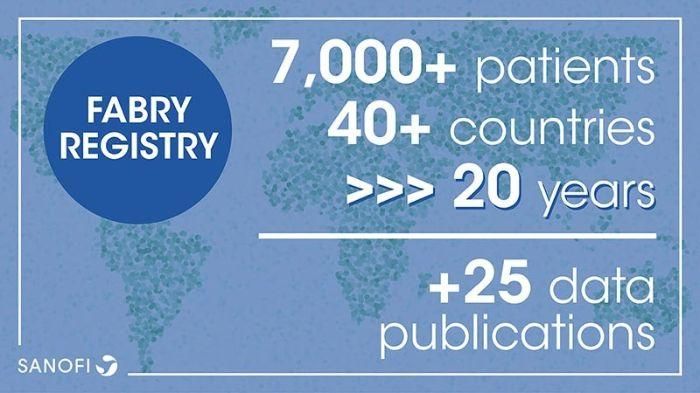En quoi les registres accélèrent la recherche sur les maladies rares

Patients who share their experience contribute meaningfully to scientific advances
Living with a disease that is poorly understood can be difficult and frustrating for patients and their families, and for the clinicians who care for them. This is especially true for rare diseases, where small patient numbers, incomplete knowledge of the illness, and the lack of diagnostic expertise globally can pose significant obstacles. But disease registries can help overcome these challenges and even propel the development of new treatments.
“Sanofi has a long history of developing therapies for orphan diseases, and recognized the power of disease registries early on," said Joseph Bender, Head of Global Rare Disease Registries at Sanofi. "With such geographically distributed groups of patients, it was clear that collecting real-world data about their health experiences and outcomes in one place would be invaluable to research. Because of that pioneering vision, registries have now become a cornerstone in advancing new therapies. They represent real-world findings from many thousands of people living with rare diseases, and the physicians who treat them, over the course of many years."
Sanofi Rare Disease Registries are the home for real-world findings from nearly 15,000 people living with rare diseases. They have helped researchers publish studies describing the underlying biology of disease, identify risk factors impacting treatment outcomes, and share guidelines for monitoring and treatment.
The power of patient registries
Voluntary patient registries are secure, organized databases that aggregate health, wellbeing, and medical care information from individual patients with a specific disease over many years–even decades. A patient's healthcare provider can add information such as disease signs and symptoms, measures of health and disease progression, clinical assessments, and treatments as well as patient-reported outcomes and health survey data.
Because people living with rare diseases are not concentrated in any one part of the world, contributing information about their experiences in a central resource has been a major boon to research. It also cultivates a sense of the broader community’s needs.
“We are deeply grateful to patients for sharing their medical journeys with us,” said Julie Batista, Director of Epidemiology and Biostatistics for Rare Disease Registries at Sanofi. “We certainly wouldn’t understand rare diseases nearly as well as we do today without the contributions of the rare-disease community.”
Sanofi sponsors Rare Disease Registries spanning four diseases, including Gaucher, Fabry, Mucopolysaccharidosis I (MPS I), and Pompe. All four are global collaborations, representing input from patients and physicians in over 60 countries. Since 1991, when the first Sanofi rare disease registry was established, the registries have grown to represent one of the largest collections of real-world data for rare diseases. They enable registry researchers to look deeply into the data shared by an individual patient, and to find commonalities among all people worldwide with the same rare condition.
Advancing Fabry disease R&D
Sanofi’s Fabry Registry has been tracking patient journeys since 2001, providing valuable insights into the long-term impact of the disease and fueling ongoing research. Comprising over 7,000 people with Fabry disease, it is an unparalleled source of patient real-world data.

“There are fewer than 15,000 people living with Fabry disease in the entire world and we’ve been able to support the inclusion of more than 7,000 of their health journeys in the registry," said Manish Maski, Head of Rare Nephrology, Global Medical Affairs at Sanofi. "That is incredibly important for research that could benefit not only the people who participate in the registry, but many others living with Fabry disease.”
Research based on Fabry Registry data has contributed to expanding knowledge of the disease, notably helping to dispel the misunderstanding that women are not impacted. It has helped clarify the role of sex, genetics, and the impact of treatments, and has resulted in more than 25 publications for the medical research community.
Maintaining disease registries over the long term
Unlike clinical trials, which typically yield results in just a few years, registries may take many more years to gather enough data to support rigorous analyses. Registries collect data that emerges as patients undergo routine health care–there is no pre-determined schedule of exams or evaluations that must be completed.
“If properly built, registries allow for very rich and detailed analyses of patient data that support the generation of real-world evidence to inform rare disease,” said Batista. “If there is a medical need, registries could provide analysis of existing data, or evolve to include the right source of data to help address it."
Disease registries supported by Sanofi maintain the information healthcare providers supply as confidential, in accordance with national privacy regulations, other laws relating to medical information, and informed consent forms signed by registry participants. The company supports registries through maintenance, data collection, data management, statistical analyses, and regulatory review, and strives to apply the same strict operating procedures and guidelines used for clinical trials, in compliance with local and international privacy regulations.
Découvrir plus

Inspiré par des patients atteints de maladies rares aux quatre coins du monde
Références
Fuller M, Meikle PJ, Hopwood JJ. Epidemiology of lysosomal storage diseases: an overview. In: Mehta A, Beck M, Sunder-Plassmann G, editors. Available from: https://www.ncbi.nlm.nih.gov/books/NBK11603/ Accessed 18 January 2021
Germain DP, Oliveira JP, Bichet DG, et al. Journal of Medical Genetics. 2020 Aug;57(8):542-551. DOI: 10.1136/jmedgenet-2019-106467
Kingma SD, Bodamer OA, Wijburg FA. Clinical Endocrinology & Metabolism. 2015 Mar;29(2):145-157. DOI: 10.1016/j.beem.2014.08.004
Mignani R, Pieroni M, Pisani A, et al. Clinical Kidney Journal. 2019 Feb;12(1):65-70. DOI: 10.1093/ckj/sfy108
National Institutes of Health, U.S. National Library. (2019, Sep 10). Retrieved from https://ghr.nlm.nih.gov/condition/fabry-disease#definition, Accessed: 18 January 2021




